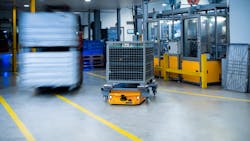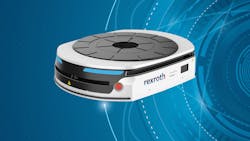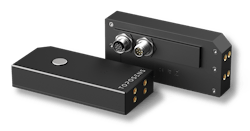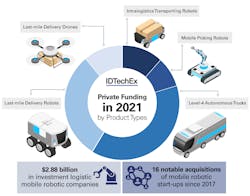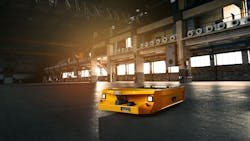The autonomous mobile robot (AMR) market is projected to be on a steady growth path over the coming years. Their use in manufacturing and logistics applications in particular has increased as a means of helping overcome labor challenges.
An October 2021 report from Interact Analysis projects that by the end of 2025 almost 2.1 million mobile robots will have been shipped to customers. The research firm sees strong demand for both automated guided vehicles (AGV) and AMR in the next 5 years, but the greater application use of AMR will see its market growth outpace that of AGV.
Both AGV and AMR are types of unmanned guided vehicles (UGV) often utilized to move material around a facility. Whereas AGVs follow a set of predetermined paths, AMR can move about freely and collaborate with humans for material handling tasks.
Download the free ebook “How AGVs and AMRs Move Manufacturing Forward” from our colleagues at Machine Design to learn more about the differences between AGV and AMR, the technologies utilized for each and their various use cases.
Interact Analysis’ report points to labor shortages as well as costs, flexibility of manufacturing lines and the continued e-commerce boom as drivers for the future growth of AMR.
Research from IDTechEx released in January 2022 also forecasts strong growth for the mobile robot market, particularly in the manufacturing, delivery, and logistics sectors. It foresees the market reaching a value of $83 billion in 2032 and $334 billion in 2042.
According to Pete Jadwinski, Sales Manager, America in Motion (AIM)—a company which develops custom automated solutions—the market for AGV and AMR has changed drastically over the last 5 years. “Labor shortage is the key driver,” for the market’s growth he said during a Power & Motion hosted webinar (see sidebar below).
Many industries are finding it difficult to find skilled labor. Therefore, they have begun to implement solutions like AMR. Doing so enables work to be completed even if short on staff, allowing businesses to remain productive.
Use of mobile robots can also help improve safety and employee comfort by doing tasks that might otherwise be difficult or have the potential to cause harm, such as lifting of heavy objects. Workers can then be freed up to focus on other tasks, as well.
Motion Control Advancements Benefit Performance, Market Uptake
Ongoing advancements in the various motion control technologies utilized by AMR have enabled their increased use in recent years.
“The processing power of computers and amount of data they can handle and compute at such a high rate has made a big difference” in recent years said Jadwinski. Related to this have been improvements in sensor technology and other components which are all working together to enhance performance of AMR.
Through the many technological advancements taking place has been the ability to make the autonomous vehicles smarter, leading to a shift from AGV to AMR because of the latter’s ability to understand and interact with its environment. “A big part of this is increased processing capabilities, better sensors [and] better software,” said Tobias Bahnemann, CEO and Co-Founder, Toposens GmbH, during the Power & Motion webinar.
“It is a super dynamic time for the market,” he added. “There are new things updated on almost a monthly basis…there is more movement than ever.”
Toposens, for instance, recently introduced its ECHO ONE sensor for mobile robot collision avoidance systems. The sensor utilizes 3D ultrasonic echolocation technology to provide improved visibility of the environment around a robot and thus increase safety. Typically, 2D Lidar sensors have been utilized to prevent collisions with humans. But Bahnemann said the market has started to understand the need for detecting more than just people, necessitating the use of 3D collision avoidance systems.
Jadwinski said AIM has seen development of broader software suites from its component suppliers. More CANbus routines are available as well to make the implementation and integration of the Internet of Things (IoT) and Industry 4.0 easier for manufacturers like AIM. This is enabling more connectivity and data to be collected for operational improvements.
“The market is maturing. Five years ago, I had to explain what an AGV was to customers,” said Jadwinski. But now he said the market has reached a point where customers are demanding the levels of performance and integration they desire for their autonomous solutions.
Advancements in technology have also helped to bring down costs, further benefitting market uptake. “All of these components, which have been very expensive in the past, are getting to at least a moderate cost level,” said Bahnemann. “And with lower cost, the acceptance [of AMR] in the market is rising.”
Applications and Use Cases will Grow
According to IDTechEx’s report, mobile robots will take many forms over the coming years including transport robots like the AMR seen in many factories today as well as mobile picking robots, drones, last-mile delivery robots and more.
HAWE Hydraulik, for instance, has introduced the ROVO robotic platform specifically for use in off-highway applications. It features a heavy-duty design for use in harsh operating environments and a HAWE-designed battery pack which is exchangeable for continuous operation. The robot can be configured for a variety of uses such as agricultural mowing and watering or underground construction work.
Components used in the robot meet automotive standards, ensuring safety and performance. A CANbus interface is included to enable external control and fully autonomous operation is feasible with add-on technologies from partners such as Universal Robots and STW.
More companies like HAWE are entering the mobile robot market, as well. For manufacturing facilities, Bosch Rexroth and Continental have both recently introduced AMR platforms. Bosch Rexroth’s MP1000R uses the company’s RoKIT Locator Software to autonomously navigate through dynamic environments. It has a payload capacity of 1,000 kg, enabling it to be used in place of manual forklifts and tuggers. The AMR includes 360-degree obstacle detection and anti-collision bumpers to ensure safe operation.
Continental’s newly launched AMR portfolio were first tested in its own facilities and are now being made available to the external market. Features the company points to for its AMR include the ability to carry loads up to 1.2 tons at speeds up to 2.0 m per second as well as increased torque, a shorter turning radius and optimized sensor coverage.
The robots are available from the company’s newly formed business, Continental Mobile Robots. Like many companies, Continental has seen the growth potential for robots in various applications. It developed the AMR in-house which allowed the company to utilize its expertise in a variety of areas including sensors and other motion control technologies. The company has also developed mobile robots for agricultural applications, demonstrating the versatility of solutions it can provide.
In the coming years, technology for AMR will continue to advance in order to meet current and future challenges such as increasing the speed at which these vehicles can safely operate. As the technology advances, so too will the configurations and applications in which AMR can be utilized.
“There is huge room for growth,” said Bahnemann in regard to ongoing technology and market developments for AMR. “But there are also some near-term [improvements] like increasing efficiency and safety.”
“I see most of the growth coming from component manufacturers increasing their capabilities as far as software and IoT go,” said Jadwinski. “Everything is going to web-based, and these sensors are just getting more and more impressive every day.
“The sensor- and component-level growth, combined with the number of AMRs out there, is kind of bridging the gap between an AGV and an AMR capability,” he concluded. “And the friendly and healthy competition makes all of it better. It is an exciting time to be doing what we are doing.”
About the Author
Sara Jensen
Executive Editor, Power & Motion
Sara Jensen is executive editor of Power & Motion, directing expanded coverage into the modern fluid power space, as well as mechatronic and smart technologies. She has over 15 years of publishing experience. Prior to Power & Motion she spent 11 years with a trade publication for engineers of heavy-duty equipment, the last 3 of which were as the editor and brand lead. Over the course of her time in the B2B industry, Sara has gained an extensive knowledge of various heavy-duty equipment industries — including construction, agriculture, mining and on-road trucks —along with the systems and market trends which impact them such as fluid power and electronic motion control technologies.
You can follow Sara and Power & Motion via the following social media handles:
X (formerly Twitter): @TechnlgyEditor and @PowerMotionTech
LinkedIn: @SaraJensen and @Power&Motion
Facebook: @PowerMotionTech

Leaders relevant to this article:
